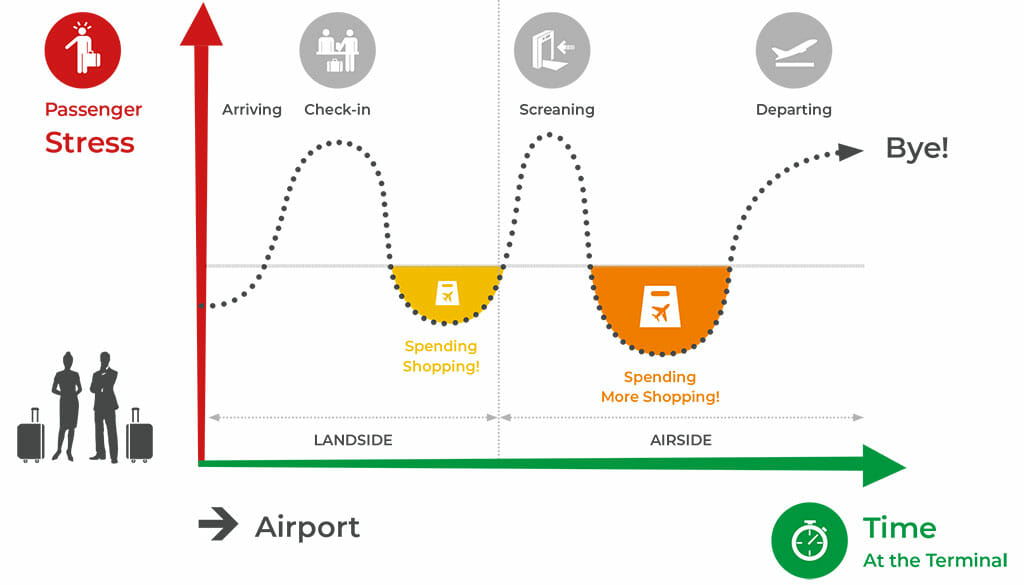When we think about designing future airports, we face the challenge of making them easier, faster, safer, friendlier and greener.
Currently, the passenger experience concept is, in terms of both space and process distribution, a key point in airport design to make terminal buildings friendlier.
One of the current keys to airport development is the constant improvement of the passenger experience and, for this purpose, it is essential to properly anticipate their stay times and actions.
In this context, shopping areas have not only become a strategic business unit, but, by meeting specific passenger needs and creating leisure spaces with unique experiences, they are expanding possibilities to improve the passenger experience.
In order to define a robust programme for shopping areas within the terminal, designers need to know an airport and its operation, which thus requires knowing the passengers.
The type of passenger that uses the airport conditions the design of commercial areas as follows:
- The percentage of international versus domestic passengers. International passengers usually travel longer distances, tend to have higher incomes and are more likely to spend. An international passenger connecting to a domestic flight also tends to spend more when using a national terminal compared to a passenger who makes a purely domestic connection. Airports with significant international connections, such as Istanbul and Doha airports, have higher passenger spending rates due to the number of passengers connecting internationally. Therefore, the needs of commercial areas are greater at international than domestic airports.
- The number of companions who go to an airport to drop off or collect passengers and the time they spend at the airport is also important. Longer stay times in a terminal correlate to higher sales. In the case of these potential customers, food and drink and informal food restaurants come into play. Airports where the number of companions is higher have to include more concessions of this type on the land-side of the terminal (before the security checkpoint).
- It is also important to consider the average duration of a trip. Passengers who travel short distances tend to arrive later and spend less time in a terminal. On average, passengers on short journeys spend less money than those on long journeys, who are more likely to shop at airport stores and purchase food and drink to use or consume during the trip.
- The layout of shopping areas is always far more extensive after the security checkpoints than before. The balance between the two locations depends on the number of connecting passengers in the terminal: the higher the percentage of connecting passengers, the higher the percentage of air-side shopping areas.
- The volume of sales in concessions is proportional to passenger stay time. Up to a certain point, longer stay times in the terminal mean more sales, especially in food and drink, such as informal food restaurants, and in specialised retail shops.
 However, we have to analyse how a passenger spends their time at the airport and the stress level that the different processes cause, and thus identify the best place to incorporate shopping areas. The passenger’s stress at an airport peaks in the security checkpoint, followed by passport control and check-in. The time after these processes are complete must be put to good use so as to offer activities that improve the passenger experience
However, we have to analyse how a passenger spends their time at the airport and the stress level that the different processes cause, and thus identify the best place to incorporate shopping areas. The passenger’s stress at an airport peaks in the security checkpoint, followed by passport control and check-in. The time after these processes are complete must be put to good use so as to offer activities that improve the passenger experience
- The geometry of terminals and the distribution of passenger flows affect the ability to create concessions that are seen by a greater number of passengers. Older terminals are generally not optimised for concessions. It is also necessary to consider passenger walking distances, the time needed to reach the boarding gates and boarding information times in order to balance the needs of the airport (longer passenger time in shopping areas) with those of the passenger (able to relax during the process by providing the right information at the right time).
Once the specific characteristics of a terminal are known, the commercial areas can be designed to improve the passenger experience by:
- Including the right mix of shopping services at every point in the passenger’s airport stay, from check-in to the boarding gate.
- Ensuring that the stores are located in the passenger flow.
- Combining food and beverage with shops and Duty Free, and not having them in separate areas, so as to enhance synergies between the different models.
- Designing these areas using an open-plan layout with no walls.
- Not forgetting the arrivals area, including primarily Duty Free areas.
- Designing areas for companions in both departures and arrivals.
Like all other facilities, the commercial areas of an airport fulfil a specific function in an airport environment, while also being conditioned by the specifics of said environment. Their design must therefore be suited to each specific use case.



